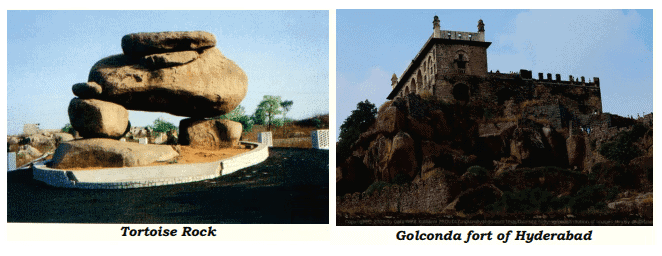Geological Heritage Chapter Notes | Communicative English for Class 10 PDF Download
| Table of contents |

|
| Key Points of the Story |

|
| Detailed Summary |

|
| Theme/ Message |

|
| Difficult Words |

|
Key Points of the Story
- Hyderabad is famous for its unique granite rocks that are very old, even older than the Himalayas.
- These rocks have interesting shapes that people like to imagine as different things, such as animals or objects.
- Some rocks have become landmarks and are even used as places of worship by local people.
- The rocks help keep the environment healthy by supporting lakes and ponds, which provide homes for many plants and animals.
- Unfortunately, many of these rocks are being destroyed to make way for new buildings, roads, and other construction projects.
- The city’s population has grown rapidly, leading to more demand for construction materials, which are taken from these ancient rocks.
- Many rocks have been quarried illegally at night, causing great damage to the environment.
- People are slowly realizing the importance of these rocks and some are working to protect them through organizations like the Society to Save Rocks.
- The government has started to protect some rock formations as a part of the city’s heritage.
- Despite some efforts to save the rocks, the conflict between development and conservation continues, especially in places like Durgam Cheruvu.
- Some people have found ways to incorporate rocks into their homes, showing that rocks can be part of modern living without being destroyed.
- The story highlights the need for more awareness and action to protect these geological treasures for future generations.
Detailed Summary
These rocks play an essential role in the environment by facilitating water drainage and creating natural water bodies like lakes and ponds. This hydrological function supports diverse plant and animal life, making the surrounding areas rich in biodiversity. However, as Hyderabad rapidly urbanizes, these natural formations are being destroyed to accommodate new developments like buildings and roads.

Construction activities have surged due to population growth, leading to the extensive removal of rocks and soil, often occurring without proper permissions. This destruction has resulted in many once-beautiful landscapes being replaced by rubble. The loss of these rocks diminishes the city’s natural water retention capabilities, negatively affecting greenery and the overall ecosystem.
Despite the emphasis on urban development, some individuals and organizations are advocating for the protection of these rocks. Since 1996, the Society to Save Rocks has focused on raising awareness about their significance and has succeeded in securing legal protection for certain rock formations, designating some as heritage sites.
One notable area they have worked to preserve is Durgam Cheruvu, a lake that has transformed into a tourist destination, but with surrounding hills facing destruction. This situation highlights the ongoing conflict between urban expansion and environmental conservation.
Some individuals have found creative ways to incorporate these rocks into their homes, using them in architecture and furniture design. However, this often stems from aesthetic considerations rather than genuine environmental concern.
Thanks to advocacy groups, awareness of the rocks' importance is growing. Nevertheless, the pressure from construction and urbanization continues to overshadow conservation efforts. For the future of these ancient treasures, collective action from residents, visitors, and government authorities is essential. Protecting these rocks is vital, as their loss signifies the disappearance of a significant aspect of nature and heritage in Hyderabad.
Theme/ Message
- The main theme of the chapter is the balance between development and conservation. It shows how important it is to protect nature while also allowing for growth and progress.
- The chapter emphasizes the value of natural heritage, reminding us that ancient rocks are part of our history and identity.
- It conveys a message about the responsibility of citizens to care for their environment and to support conservation efforts.
- There is a strong message that the destruction of nature can lead to negative consequences, like losing natural beauty and biodiversity.
- Finally, it encourages collective action, suggesting that everyone—individuals, communities, and governments—should work together to protect the rocks and the ecosystem they support.
Difficult Words
- Heritage: Something that is handed down from the past, like traditions or natural wonders.
- Mesmerize: To hold someone’s attention completely, making them fascinated.
- Ecological: Related to the relationship between living things and their environment.
- Quarried: To extract stone or other materials from the ground.
- Subterranean: Existing or occurring under the ground.
- Depletion: The reduction in the number or quantity of something.
- Sentinels: Guards or watchful protectors, often referring to nature's creations.
- Flora: The plants of a particular region or environment.
- Fauna: The animals of a particular region or environment.
- Conservation: The act of protecting something, especially the environment.
- Precincts: The area surrounding a particular place, often used in the context of a city or park.
- Symbolic: Serving as a symbol, representing something else.
- Apathy: Lack of interest or concern about something.
- Residential: Relating to areas where people live.
- Development: The process of growing or improving something, often in terms of buildings or infrastructure.
|
8 videos|250 docs|8 tests
|
FAQs on Geological Heritage Chapter Notes - Communicative English for Class 10
| 1. What is geological heritage and why is it important? |  |
| 2. How can geological heritage be protected? |  |
| 3. What are some examples of geological heritage sites? |  |
| 4. How does geological heritage contribute to tourism? |  |
| 5. What role does education play in promoting awareness of geological heritage? |  |













